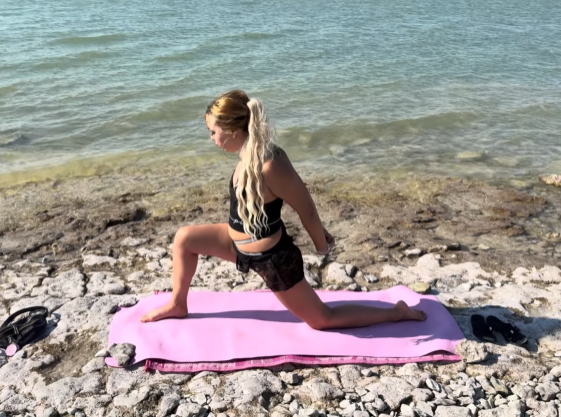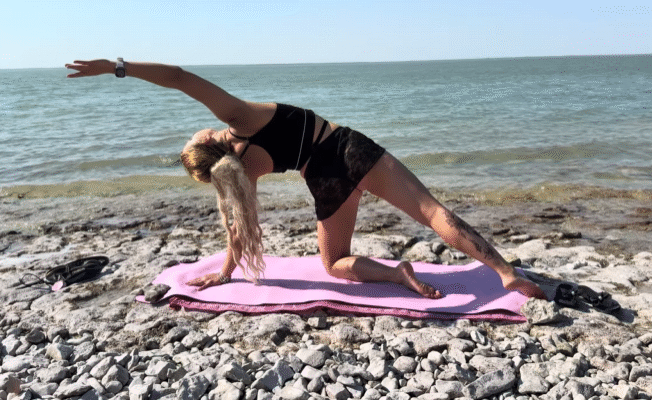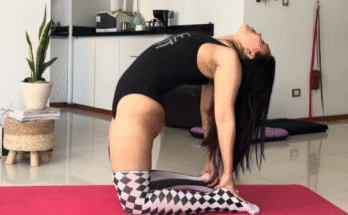
The early morning sky was still painted in soft shades of lavender and rose when I stepped outside, barefoot, feeling the earth cool beneath my feet. The world was quiet—no engine sounds, no chatter, no rush—just the calm hum of nature beginning to wake. A gentle, fresh breeze brushed over my skin, and somewhere in the distance, a bird welcomed the sunrise with a single, clear note. It was the perfect moment to begin my day with yoga, especially one of my favorite grounding poses: the Low Lunge.
I laid my mat down in a patch of smooth grass, still damp with morning dew. The scent of the earth was rich, calming, and impossibly healing. There’s something different about practicing yoga outside—something you cannot recreate inside four walls. The breeze becomes your breath, the sounds become your guide, and the sunlight becomes your teacher. As I stood at the top of the mat, I took a long breath in, letting the crisp air fill my lungs, then exhaled slowly, allowing the remnants of sleepiness to drift out of my body.
This morning practice wasn’t meant to be long or strenuous. Instead, it was meant to set the tone for the day—a few slow movements to open the hips, release tension in the legs, and awaken the spine. The Low Lunge pose, or Anjaneyasana, felt like the perfect way to honor the morning air, the sky, the ground, and the simple beauty of waking up alive.
I began with a gentle warm-up. Stepping into a soft forward fold, I let my head hang heavy, the weight of sleep sliding down my spine. The trees swayed above me, their branches forming shadows that moved across my arms as the sunlight grew brighter. After a few breaths, I placed my hands on the ground and stepped my right foot back, lowering my knee gently to the earth. Here it was—the Low Lunge—simple, grounding, yet transformative.
As my left knee bent forward and my right leg stretched behind me, I could feel the deep pull through my hip flexor, a place where tension loves to hide. But the earth under my knee felt forgiving, and the cool air made the stretch feel more refreshing than intense. I pressed my fingertips into the mat, lengthened my spine, and inhaled deeply. The air carried the scent of grass, and for a moment, it felt like time slowed into stillness.

Lifting my chest, I slowly raised my arms overhead, palms facing the sky. The Low Lunge opened not only my hips but my heart—my chest rising with each breath. The sunlight began to warm my skin, and even with the stretch, there was a softness to the pose. It was like the earth itself was holding me steady. I felt stable, supported, grounded.
With each inhale, I imagined drawing in the morning energy—fresh, renewed, full of potential. With each exhale, I let go of anything that didn’t belong to this moment. Stress, worry, leftover emotions—they all dissolved into the cool air. Nature has a powerful way of reminding us that release is necessary for growth. Trees shed leaves, rivers shed water, and here I was, shedding tension through breath.
After holding the pose for a few breaths, I gently shifted my weight back into a half-split stretch, extending my front leg and letting the hamstring lengthen slowly. The dew on the grass sparkled like diamonds, and the distant rustling made the moment feel almost enchanted. Then I glided back into my Low Lunge once more, breathing deeply, savoring the sensation of opening.
Switching sides, I repeated the pose, this time stepping my right foot forward and stretching the left leg behind. Each side of the body told its own story—one felt tight and protective, the other felt open and ready. Yoga in nature teaches you to listen—not just to birds or wind—but to your own body. When I lifted my arms again, the breeze wrapped around them like a soft ribbon, making the pose feel alive, dynamic, and connected.

The more I sank into the stretch, the more I felt rooted in the present. I could hear leaves fluttering, insects buzzing softly, and the faint echo of a stream somewhere beyond the trees. Practicing in nature isn’t just movement—it’s an entire sensory experience. The fresh air cools you, the sunlight warms you, and the sounds fill the spaces your thoughts usually occupy. There’s no room for hurry here. No place for stress. No need for perfection.
The Low Lunge became a moment of gratitude. Gratitude for movement, for breath, for the morning, for the simple fact that my feet could touch the earth. I noticed how my body responded—muscles lengthening, tension melting, energy building. It was gentle, yet powerful. Slow, yet awakening.
After completing both sides, I transitioned into a soft kneeling position, resting my hands on my thighs. I closed my eyes, feeling my heartbeat steady and strong. The morning air felt cooler now on my warm skin, a refreshing contrast that awakened me more fully than any cup of coffee ever could. I took one last deep breath—long, full, nurturing—then released it with a quiet sigh.
My practice wasn’t long. It wasn’t complicated. It didn’t need to be. It was a simple moment of movement and breath in the fresh morning air, and sometimes, that’s all we need. To reconnect. To reset. To remember that our bodies are capable, our minds are strong, and our mornings can be peaceful if we choose them to be.
As I rolled up my mat, the sun had fully risen, casting golden light across the grass like a soft blanket. The world felt brighter, clearer, fresher. And so did I.
A Low Lunge in nature—simple, grounding, magical—was enough to remind me that every new day gives us a chance to stretch open to life again.
And today, I welcomed it fully. 🌿🌤️🧘♀️



